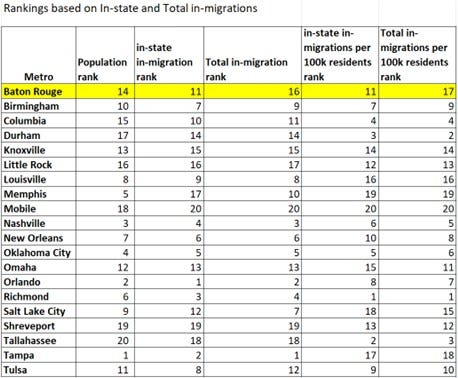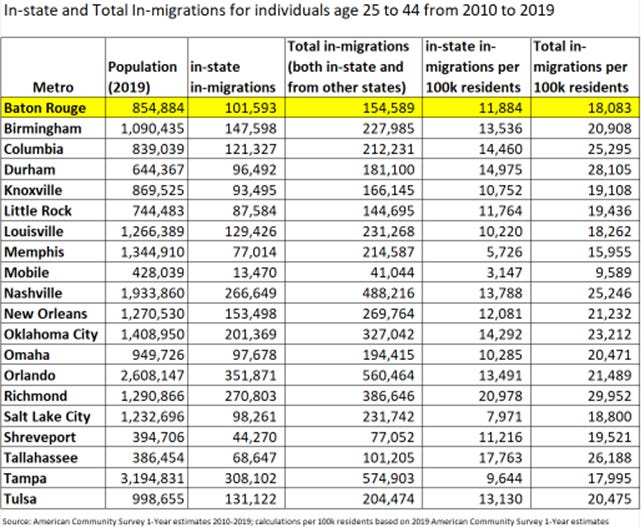The Battle for Young Talent
As BRAC and its strategic partners work to attract and retain young talent for the Capital Region, let’s take a look at how the region has fared over the last decade
[Part 1 in a BR by the Numbers series on Capital Region migration patterns]
BRAC’s new five-year strategic plan includes four “big outcomes,” the first of which is to “increase the region’s young professional population by 5 percent.” Demand for “young professionals,” defined by BRAC as labor force participants between the ages of 25 and 44, is evident considering the number of metros that have launched spirited talent attraction campaigns over the last few years1234.
This post will dive into young professional in-migration patterns to help us understand where movers to the Baton Rouge metro are coming from. The term “in-migration” is used to refer to people moving from elsewhere into the Baton Rouge metro (or a peer metro). We looked at American Community Survey one-year estimates from 2010 to 2019 for Baton Rouge and nineteen peer metros to better understand how Baton Rouge stacks up against comparable regions when it comes to attracting young professionals. This analysis uses historical data to help us understand future migration patterns.
Most young professionals moving to Baton Rouge come from elsewhere in Louisiana
About two of every three young professionals who moved to the Baton Rouge metro from 2010 to 2019 came from another Louisiana parish5. This shows that Baton Rouge is a hub for in-state talent. This also means that out-of-state residents make up a small share of the metro’s total in-migration. Only Richmond, Virginia and Tallahassee, Florida had a greater share of in-state young professional in-migration compared to total young professional in-migration. These three cities are all state capitals with large college populations which points to the strong influence these metros hold across their respective states.
Baton Rouge’s statewide appeal is considerably stronger than its appeal to out-of-state young professionals
Baton Rouge attracts more in-state young professionals than its population would suggest. With the 14th largest population of the twenty metros included in this analysis, Baton Rouge had the 11th most young professional in-state in-migrations from 2010 to 2019. When adjusted for population size, Baton Rouge ranks 11th for in-state in-migrations and 17th for total in-migrations. This represents the greatest difference between the two rankings of any metro in this analysis.
When adjusted for population, most metros have similar rankings for in-state in-migration and total in-migration. The difference between Baton Rouge’s in-state and total in-migration ranks suggests that Baton Rouge’s statewide appeal to young professionals is stronger than the metro’s appeal to out-of-state residents.
In fact, Baton Rouge had the smallest net difference between in-state and total in-migrations per 100,000 residents which indicates that Baton Rouge had the fewest in-migrants from other states and other countries when adjusted for population.
Taking all these data together lead us to believe that young professional in-migrations into Baton Rouge are overwhelmingly driven by in-state residents, and that Baton Rouge has considerably stronger appeal to in-state rather than out-of-state young professionals. The factors behind Baton Rouge’s ability to attract in-state young professionals at comparably high rates are less clear, but these data provide a key insight into where future Capital Region talent may come from.
The battle for talent
The Baton Rouge Area is not alone in its desire to attract young talent. Cities across the country are working hard to make themselves more attractive to young professionals. Based on historical data, it’s clear that Baton Rouge’s competitive advantage is in attracting young Louisianans to relocate to the Capital Region. This is a valuable insight and is important to consider as our metro grapples with an intense labor shortage causing thousands of jobs to go unfilled. The major question BRAC will try to answer via its new five-year strategic plan is how the Capital Region can broaden its appeal and attract more out-of-state talent while retaining the talent already here.
https://www.cleveland.com/business/2020/01/destination-cleveland-launches-talent-attraction-effort-to-boost-regions-workforce.html
https://www.daytondailynews.com/business/effort-intensifies-to-attract-retain-talented-workers-in-dayton-region/VCO52NIPWBC6NPCUVDXB4JT6VI/
https://www.dmagazine.com/publications/d-ceo/2018/august/how-dallas-fort-worth-stacks-up-in-the-race-for-young-professionals/
https://memphismagazine.com/features/columns/closing-the-talent-gap/
This does not include those who moved within the Capital Region from one parish to another.






